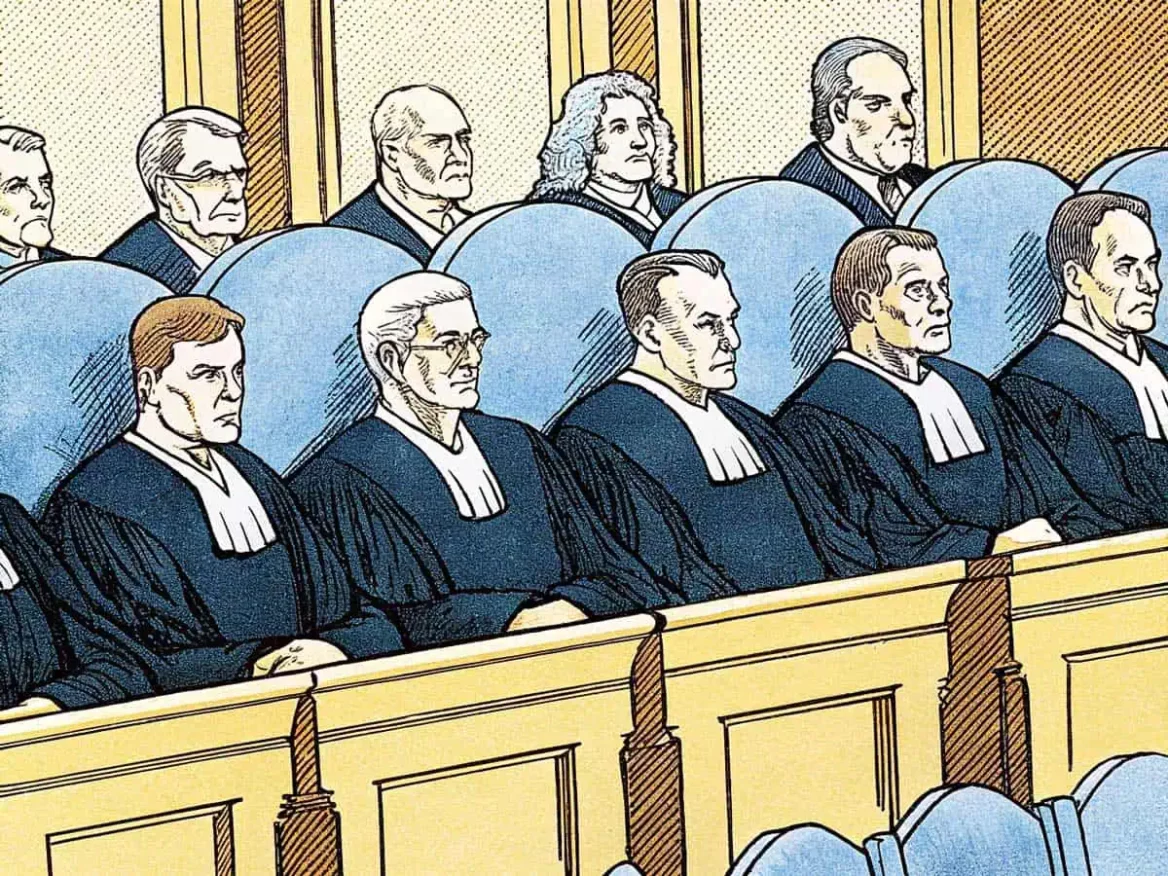Following a Swedish court case, I examine whether judges can be considered ‘public’ under the Copyright Directive. Disclosing evidence to a judge is not without consequences.
Honourable Sir/Madam, Prejudicial questions to the Court: is the judge public?
A pleading or court appearance is sometimes a bit like a performance or show. Keeping the agenda free on the day in question, rehearsing the text, putting on the costume (the robe) and, of course, the audience (the judge, court clerk and any interested parties) eagerly awaiting what (the lawyers of) the parties have to say.
But is the public, and in particular the courts, also to be considered public within the meaning of Directive 2001/29/EC (‘the Copyright Directive’)?
The right to disclose
Copyright grants the creator of a work the exclusive right to publish and/or reproduce it. This means that in terms of reproduction, the creator can prohibit another person from copying, translating or filming his or her work. In terms of disclosure, a creator can prohibit another person from posting a work online, performing it over the radio, or broadcasting it on television.
For there to be a disclosure, a work must be made available (communicated) to an audience. In the case of a freely accessible website or a radio/television programme, it is now clear that there is a communication to the public and thus a disclosure.
But what if a work is provided to the court during legal proceedings? Is there then also a public to whom a communication is made making the work public? Recently, the Swedish court submitted preliminary questions to the Court on this issue.
The concept of public
This article discusses the concept of “public” within the meaning of the Copyright Directive and the preliminary questions raised by the Swedish court in response to this concept, concluding with a brief commentary on it.
The concept of disclosure includes the terms ‘communication to the public’ used in Article 3(1) of the Copyright Directive (Parliamentary Papers II 2001/02, 28482, no. 3) and ‘distribution to the public’ according to Article 4(1) of the same directive.
Under these provisions, member states should give authors the exclusive right to authorise or prohibit the communication of works to the public as well as any form of distribution of those works to the public.
The concept of communication to the public
Communication to the public occurs when persons who are not at the place where the communication originates are given the opportunity to see or hear a work. According to the Court, that concept must be interpreted broadly.
The concept consists of two cumulative elements, namely ‘an act consisting of a communication’ of a work and its communication to a ‘public’ (CJEU 31 May 2016, C-117/15, EU:C:2016:379, Reha Training v GEMA, para 35-37).
The making of the communication must use a specific technical process (different from the one used up to that point) or the communication must be addressed to a new audience (i.e. a different audience from the one the creator had in mind when the first publication of the work was authorised).
Furthermore, whether there is a profit motive may be relevant. However, the preliminary questions, and therefore this article, only address the concept of public.
According to the Court, the term “audience” refers to an indeterminate number of potential viewers and implies a fairly large number of people.
Undefined audience
In terms of indeterminacy of audience, it is about making a work perceptible in any appropriate way to persons in general, i.e. not limited to specific individuals belonging to and private group.
The Court further indicated that “a fairly large number of persons” presupposes a certain de minimis threshold, so that too small or insignificant a number of persons is excluded from the concept of public. However, the cumulative effects of making a work available to potential viewers should be taken into account.
Here, the issue is not only how many persons have access to the same work at the same time, but also consecutively (CJEU 31 May 2016, C-117/15, EU:C:2016:379, Reha Training v GEMA, para 41-44).
Distribution to the public
Finally, with regard to ‘distribution to the public’, the Court has held that this consists of a series of acts which, in any event, starts from the conclusion of a contract of sale to its performance by delivery to a member of the public (CJEU 13 May 2015, C-516/13, ECLI:EU:C:2015:315, Dimensione/Knoll, para 25).
A dispute between two private individuals, CX and BY, each with their own websites has prompted preliminary questions to the Court regarding the concept of “public” within the meaning of the Copyright Directive.
CX, in another case between CX and BY, submitted a copy of a page of BY’s website to the court by e-mail as evidence. The copy also contained a photograph that BY claimed was copyrighted. By submitting this work to the court, CX infringed BY’s copyright as a result of which it suffered damages, BY said.
Swedish constitution as basis
The Swedish constitution allows anyone to request a document submitted to a judge (except for confidential information), including documents covered by copyright.
According to the Swedish court at first instance, in view of that constitutional provision, CX, by submitting it to the court, distributed the photo to the public. However, as the court held that it had not been shown that BY had suffered damage, its claim was still dismissed.
Prejudicial questions
On appeal, the Swedish court (PMÖD) decided to refer the matter to the Court for a preliminary ruling, namely the following.
Question 1
PMÖD wants to know whether the concept of public from Articles 3 and 4 of the Copyright Directive has the same meaning.
In the reference for a preliminary ruling (Reference for a preliminary ruling 20 August 2019, C-637/19), the PMÖD considers that, as indicated above, the term ‘public’ refers to an indeterminate number of potential viewers and implies a fairly large number of people, the Court said in Reha Training v GEMA.
At the same time, in Dimensione/Knoll, the Court held that distribution to the public already exists when a copyrighted work has been delivered to a member of the public.
However, according to PMÖD, the Court did not rule on the concept of ‘public’ within the meaning of Article 4 of the Copyright Directive (as opposed to the concept of public within the meaning of Article 3 of the Copyright Directive). In that context, PMÖD thus wants to know whether the terms in the different provision should be given a uniform interpretation.
Question 2
If the first question is answered in the affirmative, PMÖD asks whether the judge then belongs to the public within the meaning of those articles. If the first question is answered in the negative, PMÖD wants to know whether the judge belongs to the public if someone communicates a work to the judge (Article 3 Copyright Directive) or if someone distributes a work to the judge (Article 4 Copyright Directive).
In the application, PMÖD considers that there is uncertainty as to how the Court’s Advisory on the ‘indeterminacy’ of the public should be understood when referring to a judge. Neither the judge nor his staff can be considered members of the public, but neither can they be considered to belong to a private group, PMÖD said.
On top of that, the number of people who can take cognisance of the work is in principle limited to those working in the court, but that number can vary and is generally quite large. In that context, PMÖD wants to know whether the judge belongs to the public within the meaning of the Copyright Directive.
Question 3
Finally, the PMÖD asks whether, in assessing whether the submission of a work to the court is a communication or distribution, it matters whether national law contains a provision allowing any person to access the documents submitted and thus the work.
For this reason, the number of potential persons who can take cognisance of the work is limited not only to the court and persons working in the court, but also to any person who, on the basis of the Swedish Constitution, requests to inspect the documents submitted to the court. PMÖD therefore asks whether this is a relevant circumstance when determining whether there is a communication or distribution.
Comment by Good Law
Whether the court belongs to the public within the meaning of Article 4 of the Copyright Directive (and whether the concept of public of Articles 3 and 4 of the Copyright Directive should be interpreted uniformly) is, in our view, irrelevant to the issue between CX and BY.
Indeed, the Court found that distribution consists of a series of acts ranging, in any case, from the conclusion of a contract of sale to its performance by delivery to a member of the public.
The submission of a work to the court, we believe, in no way constitutes or aims to constitute a commercial act as the Court seems to attach to the concept of distribution. This is true even if one takes into account the potential audience that can request access to the documents submitted to the court on a constitutional basis.
Nevertheless, it is interesting to know how the court at first instance came to the Advisory that CX’s submission of the photo concerned distribution. This, for the sake of the scope of this article, is left aside here and we will assume for now that Article 4 of the Copyright Directive does not apply. Also because the question of whether the judge belongs to the public is much more interesting.
There is also the question of the extent to which account should be taken of the public who, on the basis of the Swedish constitution, can request the documents submitted to the court.
CX merely submits the work to the judge. The judge(s) is then the one who further distributes the work if requested, and makes the work available to a public in that sense.
Initially far-fetched
It seems, initially, a bit far-fetched to argue that CX is responsible for that disclosure. This article is therefore mainly concerned with the question of whether the court and those employed by the court (and therefore not those who can request the documents) can fall under the term ‘public’.
Indeed, on this question – whether the judge belongs to the public within the meaning of Article 3 of the Copyright Directive if someone communicates a work to the judge – the Court’s Procedural law is not clear.
At first glance, there does not seem to be a fairly large number of people (in the Netherlands, there are initially one to three judges and a clerk dealing with the case), so there would be no question of ‘public’.
However, there may be many people working for or at the court who thus have access to the work, which in turn may make the group to whom the work is made available quite large (so-called cumulative effects), at least more than a small or insignificant number of people.
In that case, there would indeed be a public. Also, the work is then made perceptible to (several) persons in general, at least not to a private group, which could also constitute a public.
Should the Court find that a judge does indeed belong to the public and the case is referred back to PMÖD, the assessment of the issue between CX and BY will also include the other conditions to assess whether there is a communication to the public.
We refer to the questions:
- whether a specific technical method was used that is different from the one used up to then;
- whether the communication must be addressed to a new audience; and
- whether there was a profit motive.
In addition, it seems relevant to us whether CX can be sued for both disclosing the work to the court and disclosing the work to anyone who requests the documents submitted to the court on the basis of the Constitution.
In the latter case, should c.q. can a party be held responsible for disclosing – beyond its control – a work through a disclosure system that has its basis in a constitution?
Complications in intellectual property
Even if the judge were to belong to the public (and the other requirements for disclosure or communication to the public are met), this might create complications in practice in the Netherlands, especially for intellectual property disputes.
In principle, images of works, like the names of natural persons, could be ‘anonymised’ by removing them in the judgments that are made public. However, it is also possible to request judgements non-anonymised, which would still make a work public which would (or could) therefore infringe the creator’s copyright. The question is therefore how desirable it is for a judge to be classified as public.
Either way; whether the judgements are anonymised or not, the question remains (as also considered by the Swedish court at first instance in the matter between CX and BY) whether the creator is harmed as a result.
Watching coffee grounds
Whatever the case may be, until the preliminary questions raised by the Swedish court are answered, it remains a matter of conjecture which way the Court will go and what the consequences of this will ultimately be; also for Dutch Procedural law.
To be continued.
This article was published on 22 November 2019 in JutD 2019-0143 . The version on this website contains some minor edits and new headings.


